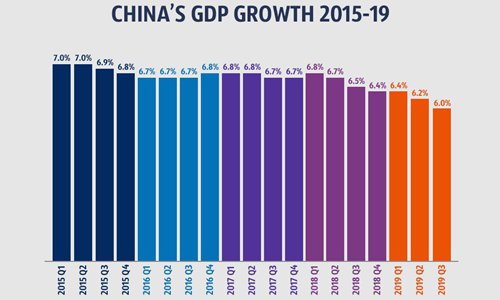HOME >> BUSINESS
Q3 GDP rises 6%, within target range
By Li Xuanmin Source:Global Times Published: 2019/10/18 19:13:40
Economy fastest among major countries, withstands trade war with US

Source: National Bureau of Statistics
Graphics: Global Times
China's GDP grew by 6.0 percent year-on-year in the third quarter, a 27-year low amid the impact of a bruising trade war with the US and other downward pressure. The figure is still within the annual target set by policymakers, and analysts forecast that this year's GDP growth rate will fall within the range as more stimulus measures kick in and economic potential further unfolds.
China's third quarter GDP grew by 6.0 percent, compared with a 6.2 percent growth pace in the second quarter, according to data released by the National Bureau of Statistics (NBS) on Friday. That translated into a growth rate of 6.2 percent in the first three quarters to 69.78 trillion yuan ($9.87 trillion), the NBS data showed.
Chinese policymakers have set a target growth range of 6.0-6.5 percent for the full year.
The third quarter GDP growth also means an increase of about $3.5 trillion in overall GDP compared with the first half of the year, which placed it closer to the GDP of Germany. In 2018, the European country's GDP reached $4 trillion, fourth in the world.
"China has been faced with mounting pressure at home and abroad… but the nation's economy managed to maintain overall stability," NBS spokesperson Mao Shengyong said at a press briefing on the release of the data on Friday.
Mao said China's economic growth rate in the first nine months leads major economies and is the fastest among world economies with a GDP of over $1 trillion.
"Compared to China's past, the growth is medium to high speed. But in a global context, it is still high-speed growth," Mao said.
"Despite a slowdown, China's economy is relatively stable and resilient. And this was hard-fought, because pressure was building," Tian Yun, vice director of the Beijing Economic Operation Association, told the Global Times.
In the first three quarters, retail sales grew 8.2 percent to 29 trillion yuan, contributing 60 percent to China's economic growth. Industrial value-added was up 5.6 percent during the same period, and fixed-asset investment rose 5.4 percent to 46 trillion yuan, the NBS said.
Employment was one of the report's highlights, refuting what some Western observers predicted would be a downturn in employment amid a protracted trade war with the US.
In the first nine months, newly employed people in urban areas totaled 10.97 million, which was 99.7 percent of the full-year target. Per capita disposable income was 22,882 yuan in the first three quarters, a growth of 6.1 percent year-on-year after deducting price factors.
"Employment stabilized the overall economic situation. As long as people have a job and see rising incomes, China's economy will sail smoothly," Gao Lingyun, an expert at the Chinese Academy of Social Sciences, a think tank, told the Global Times on Friday.
As exports slumped in the third quarter and policies to shore up investment and spur consumption need time to take effect, China's economy faced its biggest-ever difficulties during that period, Tian said.
"The prolonged trade war with the US did inflict pain on the economy, but China has withstood the gloom. Pressure will gradually ease in the fourth quarter," Tian said. He took note of China's large consumer market and its complete industrial chain, which he said differentiates the country from other economies that might have been crushed by the US crackdown, ranging from trade to technology.
In the fourth quarter, the global GDP growth rate will likely continue to slow down, but China's economy will be supported by numerous factors and maintain stable growth, Mao said, citing a rebound in infrastructure investment, the rising manufacturing industry and a pick-up in automobile sales.
Analysts noted that the fourth quarter is traditionally a peak season for consumption and investment, which bodes well for future room of growth. "Chinese buy necessities in bulk during the Singles Day shopping bonanza and ahead of the Spring Festival. Upstream suppliers recoup capital from downstream contractors and then make new investment," Gao explained.
"China will meet its annual target regardless of how China-US trade negotiations proceed," Gao noted.
But industry insiders also cautioned Chinese policymakers to guard against looming challenges, such as inflation and ballooning local debt, to avoid risks.
While cutting tax and administrative fees and other tools of counter-cyclic adjustments will continue to be a focus of government work, analysts also expect Chinese policymakers to unveil more policies to improve the business environment and attract foreign capital.
The State Council, China's cabinet, amended two financial management regulations this week to expand business scope and ease market access for foreign-invested companies and banks.
Posted in: ECONOMY